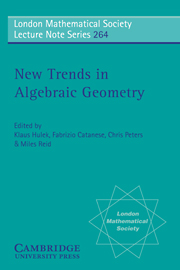Book contents
- Frontmatter
- Contents
- Foreword
- Birational Calabi–Yau n-folds have equal Betti numbers
- A Calabi–Yau threefold with non-Abelian fundamental group
- Algebraic Gromov–Witten invariants
- Kähler hyperbolicity and variations of Hodge structures
- Algorithms for computing intersection numbers on moduli spaces of curves, with an application to the class of the locus of Jacobians
- On some tensor representations of the Cremona group of the projective plane
- Hilbert schemes and simple singularities
- Bounds for Seshadri constants
- Degenerate double covers of the projective plane
- The geometry underlying mirror symmetry
- Duality of polarized K3 surfaces
- On symplectic invariants of algebraic varieties coming from crepant contractions
- The Bogomolov–Pantev resolution, an expository account
- Mordell–Weil lattices for higher genus fibration over a curve
- Symplectic Gromov–Witten invariants
- A generic Torelli theorem for the quintic
- Flops, Type III contractions and Gromov–Witten invariants on Calabi–Yau threefolds
On symplectic invariants of algebraic varieties coming from crepant contractions
Published online by Cambridge University Press: 04 August 2010
- Frontmatter
- Contents
- Foreword
- Birational Calabi–Yau n-folds have equal Betti numbers
- A Calabi–Yau threefold with non-Abelian fundamental group
- Algebraic Gromov–Witten invariants
- Kähler hyperbolicity and variations of Hodge structures
- Algorithms for computing intersection numbers on moduli spaces of curves, with an application to the class of the locus of Jacobians
- On some tensor representations of the Cremona group of the projective plane
- Hilbert schemes and simple singularities
- Bounds for Seshadri constants
- Degenerate double covers of the projective plane
- The geometry underlying mirror symmetry
- Duality of polarized K3 surfaces
- On symplectic invariants of algebraic varieties coming from crepant contractions
- The Bogomolov–Pantev resolution, an expository account
- Mordell–Weil lattices for higher genus fibration over a curve
- Symplectic Gromov–Witten invariants
- A generic Torelli theorem for the quintic
- Flops, Type III contractions and Gromov–Witten invariants on Calabi–Yau threefolds
Summary
Introduction
Let X be a smooth projective variety over the complex numbers; in standard notation, N1(X) denotes the finite dimensional vector space of 1-cycles on X modulo numerical equivalence. N1(X) contains the cone NE(X) of effective 1-cycles, generated by the classes of curves in X. In some geometric situations, the effective cone of X provides important deformation theoretic invariants of the manifold. For example, Wisniewski [Ws2] observed that the halfcone NE(X) ∩ (KXz < 0) is invariant in smooth families of projective varieties. Recently, however, Ruan has used the theory of Gromov-Witten invariants to show that, at least in dimension two and three, Mori extremal rays provide invariants of algebraic manifolds in a stronger sense [Ru]. To describe his results, let Y denote a complete C∞ manifold of real dimension 2n, and let Jo and J0 be integrable complex structures on Y such that Y0 = (Y, J0) and Y1 = (Y, J1) are projective varieties. Then we say that Y0 and Y1 are symplectically deformation equivalent if there exists a family ωt of symplectic forms on Y such that ω0 is a Hodge form on Y0 (that is, i/2n times the curvature form of an ample line bundle) and ω1 a Hodge form on Y1. There is a family of almost complex structures Jt joining J0 and J1, such that Jt is compatible with ωt for every t. If n ≤ 3, Ruan proved that every Mori extremal ray has a nonzero Gromov-Witten invariant, and so is common to Y0 and Y1. Thus Mori extremal rays are symplectic deformation invariants of low dimensional projective manifolds.
- Type
- Chapter
- Information
- New Trends in Algebraic Geometry , pp. 327 - 346Publisher: Cambridge University PressPrint publication year: 1999

